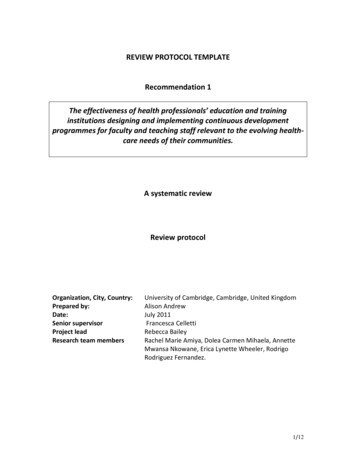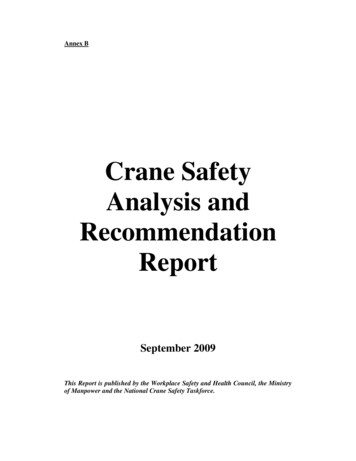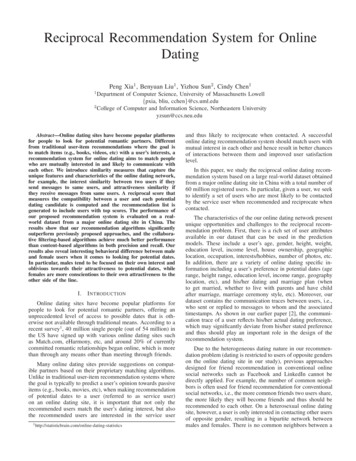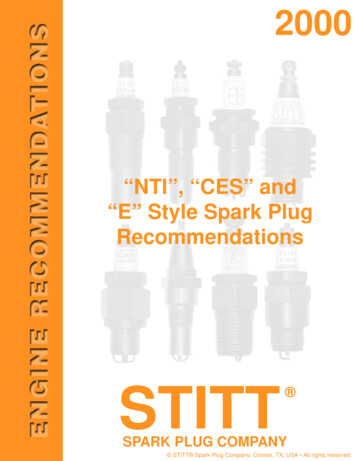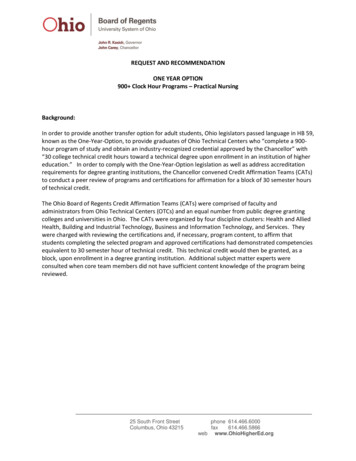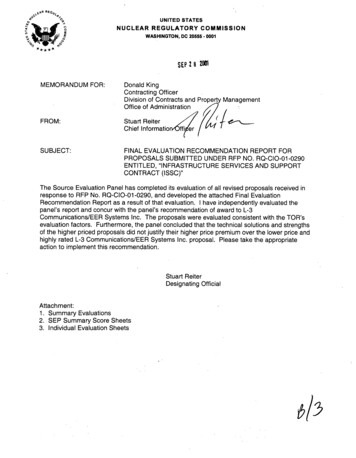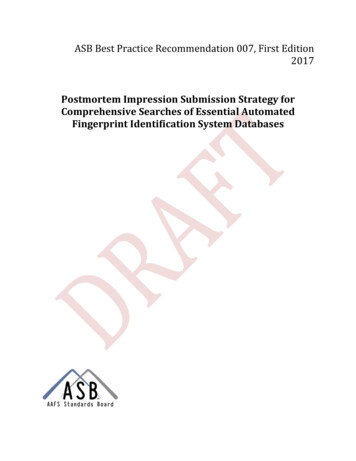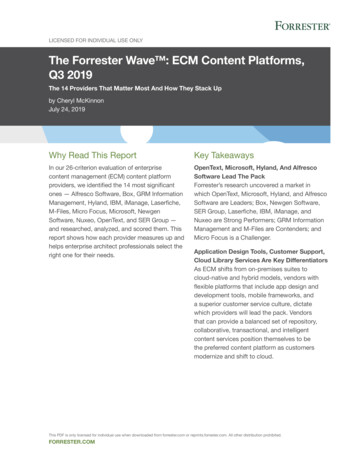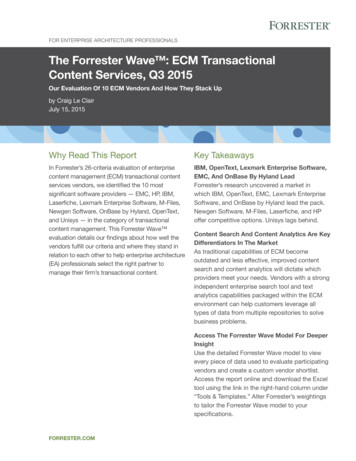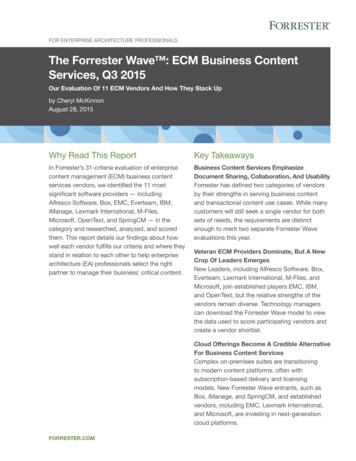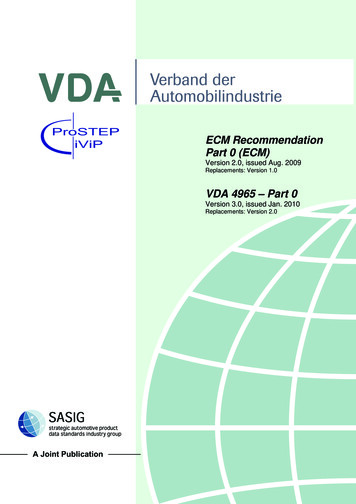
Transcription
ECM RecommendationPart 0 (ECM)Version 2.0, issued Aug. 2009Replacements: Version 1.0VDA 4965 – Part 0Version 3.0, issued Jan. 2010Replacements: Version 2.0A Joint Publication
ECM RecommendationPart 0 - ECMSASIGAutomotive Industry Action Group (U.S.), Groupement pour l’Amelioration des Liaisons dansl’Industrie Automobile (France), Japan Automobile Manufacturers Association (Japan) / Japan Auto Parts Industries Association (Japan), Odette Sweden AB (Sweden), and Verbandder Automobilindustrie (Germany) are members of the Strategic Automotive product dataStandards Industry Group- SASIG. These organisations are cooperating in the creation, distribution and use of joint documents, including PDQ (Product Data Quality), PDM AssemblyData Exchange, XMTD (Exchange and Management of Technical Data), DEV (Digital Engineering Visualization).SASIG PublicationsA SASIG publication reflects a consensus of those substantially concerned with its scopeand provisions. A SASIG publication is intended as a guide to aid the manufacturer, the consumer and the general public. The existence of a SASIG publication does not in any respectpreclude anyone from manufacturing, marketing, purchasing, or using products, processes,or procedures not conforming to the publication.Cautionary NoticeSASIG publications are subject to periodic review and users are cautioned to obtain the latest editions.Maintenance ProcedureRecognizing that this joint publication may not cover all circumstances, SASIG has established a maintenance procedure. Please refer to the Maintenance Request Form at the backof this document to submit a request.Contact informationContacts information to SASIG is available on http://www.sasig.com.Copyright and Trademark NoticeThe contents of this publication is copyrighted by members of SASIG, i.e. AIAG, GALIA,JAMA/JAPIA, Odette Sweden, and VDA. Copyright is not claimed as to any part of an original work prepared.Version 2.0, Issued: Aug. 2009Replaces: Version 1.0iii
ECM RecommendationPart 0 - ECMTable of Contents12Abstract.11.1Preface. 11.2Objectives of the recommendation . 21.3Structure of the recommendation. 21.4Notational conventions . 31.5Abbreviations. 31.6Definitions. 41.7References to standards. 8Scope and Field of Application .112.1Engineering change management tasks. 112.2Application scenarios. 122.2.12.2.22.2.32.33Recommendations for use. 15ECM Reference Process Fundamentals.173.1ECM process modeling. 173.2ECM Reference Process . 183.3ECM partner model . 203.4Global rules . 223.4.13.4.23.4.345Data oriented integration .12Process oriented integration .13Combinations of data and process oriented integration .14ECM Reference Process rules .22Interaction rules for the partners involved .23Data content rules.23Overview of the Modelling Concept and the Notation .254.1ECM process notation . 254.2ECM Interaction Scenario notation . 264.3ECM Interaction Scenario Protocol Specification notation . 264.4ECM Data Model notation. 27Cross-Sub-Process Dependencies and Relationships betweenDifferent Phases .295.1Dependencies between different ECM Reference Sub-Processes . 295.2Dependencies between ECM Interaction Scenarios of different ECMReference Sub-Processes. 295.3Dependencies between the partial ECM Data Models of different ECMReference Sub-Processes. 29Version 2.0, Issued: Aug. 2009Replaces: Version 1.0v
ECM RecommendationPart 0 - ECM6Procedural Model for the Application of this Recommendation . 317Common Resources for ECM . 357.1Common ECM Messages . 357.1.17.1.27.1.37.2Administrative messages . 35Acknowledgement, Warning, and Error Messages. 36ECM Message header and control information . 37ECM Data Model . 41Appendix A: ECM Process and Protocol Notation. 43Appendix B: Data Model Notation . 49B.1 ECM Data Model notation. 49B.2 Introduction to EXPRESS-G . 49Appendix C: IT-Architecture . 53C.1 Overview . 53C.2 Reference architecture for ECM integration . 53C.3 General decisions regarding integration. 54C.4 Implementation alternatives for integration solutions. 55C.5 Types of integration . 55C.5.1C.5.2C.5.3C.5.4Back-end data integration . 56Back-end process integration . 56Front-end data integration. 56Front-end process integration . 57Appendix D: Description of Common Messages . 59D.1 Request permissive values . 59D.2 Respond permissive values . 59Appendix E: ECM Data Model and Data Dictionary . 63E.1 ECM Data Model – EXPRESS-G. 63E.2 ECM Data Model - Data Dictionary . .10E.2.11viAcceptance . 73Acceptance relationship . 74Activity . 75Address . 75Attachment . 76Boolean value . 78Change description . 78Class . 78Class attribute . 79Class hierarchy . 80Class system . 80Replaces: Version 1.0Version 2.0, Issued: Aug. 2009
ECM RecommendationPart 0 - .2.53E.2.54E.2.55E.2.56E.2.57Comment .81Comment relationship.83Cost property .83Date .85default language string select .85description select .85Detail.85Document.87Duration .88event or date select .88event periode or date select .88event context select .88Event reference .88Explicit scope .89explicit scope select.90Functional element .90Functional element hierarchy.90functional element select .91General detail.91Header .92Id 95Id or detail select.96Id relationship.96Implicit scope .97Language .97Mass property .98Model type .98Module .99Multi language string.99Numerical value .99Object.
l’Industrie Automobile (France), Japan Automobile Manufacturers Association (Japan) / Ja- pan Auto Parts Industries Association (Japan), Odette Sweden AB (Sweden), and Verband der Automobilindustrie (Germany) are members of the Strategic Automotive product data Standards Industry Group- SASIG. These organisations are cooperating in the creation, dis-tribution and use of joint documents .
